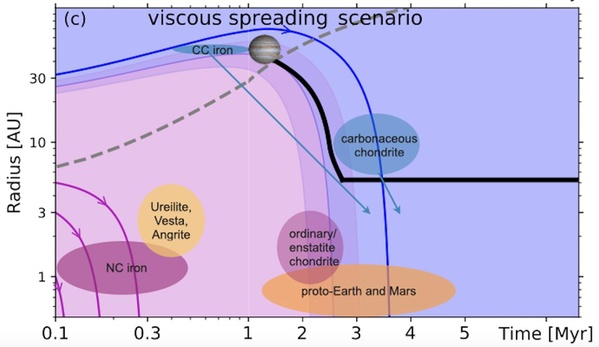Meteorites, as "guests" from outers pace, are fragments of asteroids or comets. They contain a wealth of information about the early formation of the solar system, and scientists have collected and studied these "visitors from outer space" to uncover the formation and evolution of the early solar system.
Recently, Prof. LIU Beibei from the School of Physics at Zhejiang University and his collaborators at the University of Copenhagen in Denmark and Lund University in Sweden proposed that the formation of the protoplanetary disk can generate an isotopic composition dichotomy, and on this basis, they constructed a new model for the formation of celestial bodies in the early solar system. This finding was published on the April 22 issue of the journal Science Advances.

Meteorites formed at the beginning of the solar system when a protoplanetary disk, which was the cradle of planets and meteorites, existed around the blazing sun. Meteorites display an isotopic composition dichotomy between noncarbonaceous (NC) and carbonaceous (CC) groups, indicating that planetesimal formation in the solar protoplanetary disk occurred in two distinct reservoirs.
This isotopic composition dichotomy also piqued speculation about the early evolution of the solar system in academia. To explain this phenomenon, LIU Beibei et al. focused on the gas in the protoplanetary disk. They discovered that affected by gaseous outflows, solid particles migrated at different paces and in different directions. The simulation results indicated that it would take three million years for CC particles in the outer disk to migrate into the inner terrestrial planet formation region. Before their entry, meteorite parent bodies that grew in this region formed via accretion of refractory material. CC meteorite parent bodies formed in the outer disk and grew via accretion of charcoal particles. After three million years or so, CC particles eventually migrated into the inner disk. Since then, such terrestrial planets as Earth and Mars have grown by accretion of CC particulate matter. As a result, their isotopic content is a mixture of two primary types of solid matter. "More importantly, this model predicts that the isotopic variations in different meteorites are not spatial separation but temporal evolution," Prof. Liu observed.
In this study, LIU Beibei et al. pointed out the flaws of previous theories. Some researchers contended that the rapid formation of Jupiter and the gap opening in the protoplanetary disk could explain the aforementioned phenomenon. The gap opening occurs when the planet is large enough and the gravitational effect is strong enough to clear out the gas around its orbit. This model requires that Jupiter's solid nucleus formed rapidly within one million years after the genesis of the solar system. "If Jupiter could indeed open a deep trench in the disk and completely block the inward flow of subsequent solid particles, solid materials in the inner and outer disks would be isolated from each other on their own. And NC solid particles in the inner disk would be depleted duet to rapid migration. However, meteorite dating studies indicated that NC meteorite parent bodies formed between two and three million years after the genesis of the solar system.
"Previous studies presupposed that the isotopic dichotomy is a byproduct of the formation of the largest planet in the solar system. But we found it difficult to account for the age and isotopic content of the meteorites in the solar system," Prof. Liu explained, adding that scientific research involves breaking established mindsets constantly.






